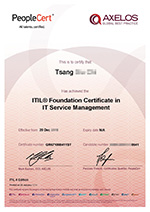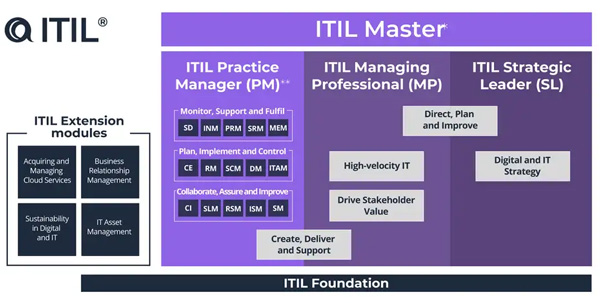日期 (dd/mm): 08/11 - 15/11
星期: 六
時間: 2:30pm - 9:30pm (dinner: 5:30pm-6:30pm)
課時: 12 小時
地點: 旺角
學費: $2,480 (另加 $3,985 考試費)
導師: Franco
# 請注意:ITIL® 官方授權機構硬性規定,報讀 ITIL® 課程時必須同時繳交相應的考試費
費用 ($2,480 + $3,985) 已經包括考試所需的費用
質素保證:免費試睇首 1 小時小時課堂錄影,請致電 2332-6544 與本中心職員預約。
半費重考,最後 1 堂之 1 個月內為保障期限。請務必向本中心購買考試券。
在校免費補堂,在校免費重讀。
(在家觀看 = 0%,在校觀看 = 100%)
100% 在校觀看日期及時間:
自由選擇,點選以下地區觀看辦公時間及位置
#(另加 $3,985 考試費)
# 請注意:ITIL® 官方授權機構硬性規定,報讀 ITIL® 課程時必須同時繳交相應的考試費
費用 ($2,232 / $2,356 / $2,480 + $3,985) 已經包括考試所需的費用
課時: 12 小時
享用時期: 報讀日至 4 星期內,進度由您控制,可快可慢。
課堂錄影導師:Franco
在校免費試睇:首 1 小時,請致電以上地點與本中心職員預約。
半費重考。開始觀看最後 1 堂之 1 個月內為保障期限。請務必向本中心購買考試券。
本課程提供在校免費重睇及導師解答服務。
(在家觀看 = 100%,在校觀看 = 0%)
100% 在家觀看日期及時間:
每天 24 小時全天候不限次數地觀看
#(另加 $3,985 考試費)
# 請注意:ITIL® 官方授權機構硬性規定,報讀 ITIL® 課程時必須同時繳交相應的考試費
費用 ($2,480 + $3,985) 已經包括考試所需的費用
課時: 12 小時
享用時期: 報讀日至 4 星期內,進度由您控制,可快可慢。
課堂錄影導師:Franco
在校免費試睇:首 1 小時,請致電以上地點與本中心職員預約。
半費重考。開始觀看最後 1 堂之 1 個月內為保障期限。請務必向本中心購買考試券。
本課程提供導師解答服務。
|
ITIL® 是 Information Technology Infrastructure Library 的簡稱。ITIL® 描述服務管理的最佳實務。由於 ITIL® 的內容建基於不同的的服務、服務經理、學術研究、顧問等,故此 ITIL ® 所描述的方法相當中肯、應用層面亦相當廣泛。ITIL® 4 是最新的 ITIL® 版本。 以下是 ITIL® 4 的 Certification Scheme
|
| 課程名稱: |
ITIL 4 Foundation Certificate in IT Service Management 國際認可證書課程 - 簡稱:ITIL 4 Foundation Training Course |
| 課程時數: | 共 12 小時課堂 (共 4 堂) |
| 適合人士: | 對 ITIL® 有興趣的人士 |
| 授課語言: | 以廣東話為主,輔以英語 |
| 課程筆記: | 本中心導師親自編寫英文為主筆記,而部份英文字附有中文對照。 |
| 1. ITIL® 認可導師: | 專業ITIL® 認可導師教授。 |
| 2. ITIL® 認可教材: | 本課程會使用本中心編制的 ITIL® 4 Foundation 認可教材教授。 |
| 3. 提供模擬考試題目: | 本中心為學員提供 ITIL® 4 Foundation 的模擬考試題目,每條考試題目均附有標準答案。 |
| 4. 考試合格保障: | 本中心 ITIL® 4 Foundation 學員於第一次考 ITIL® 4 Foundation 若不合格,可申請
半費重考 ITIL® 4 Foundation 一次,但必須符合下列的四項要求: 1. 課堂出席率須達85%或以上。 2. 學員必須透過本中心安排及於本中心應考 ITIL® 4 Foundation 考試。 3. 學員於第一次應考 ITIL® 4 Foundation 考試前,必須進行本中心的 ITIL® 4 Foundation 試前測驗,並取得90%或以上的分數。 4. 於上課結束日之一個月內作出申請。 |
| 5. 免費重讀: | 傳統課堂學員可於課程結束後三個月內免費重看課堂錄影。 |
|
學員可以選擇在本中心或在家應考 ITIL® 4 Foundation 考試。 選擇本中心考試的學員,請學員必須聯絡本中心職員以作安排。
考試環境要求:
考試電腦要求:
考試費為 HK$3,985。 |
|
課程名稱:ITIL 4 Foundation Certificate in IT Service Management 國際認可證書課程 - 簡稱:ITIL 4 Foundation Training Course |
1 Introduction
2 Quoted ITIL® text from publications
3 Bloom's levels (BL)
3.1 BL1
3.2 BL2
4 Understand the key concepts of service management [Syllabus Reference: 1]
4.1 Recall the definition [Syllabus Reference: 1.1]
4.1.1 Service [Syllabus Reference: 1.1a]
4.1.2 Utility [Syllabus Reference: 1.1b + 1.2g]
4.1.3 Warranty [Syllabus Reference: 1.1c + 1.2h]
4.1.4 Customer [Syllabus Reference: 1.1d]
4.1.5 User [Syllabus Reference: 1.1e]
4.1.6 Sponsor [Syllabus Reference: 1.1g]
4.1.7 Service management [Syllabus Reference: 1.1f]
4.2 Describe the key concepts of creating value with services [Syllabus Reference: 1.2]
4.2.1 Value [Syllabus Reference: 1.2b]
4.2.2 Cost [Syllabus Reference: 1.2a]
4.2.3 Organization [Syllabus Reference: 1.2c]
4.2.4 Output [Syllabus Reference: 1.2e]
4.2.5 Outcome [Syllabus Reference: 1.2d]
4.2.6 Risk [Syllabus Reference: 1.2f]
4.3 Describe the key concepts of service relationships [Syllabus Reference: 1.3]
4.3.1 Service provision [Syllabus Reference: 1.3c]
4.3.2 Service consumption [Syllabus Reference: 1.3d]
4.3.3 Service relationship management [Syllabus Reference: 1.3b]
4.3.4 Service offering [Syllabus Reference: 1.3a]
5 Understand the four dimensions of service management [Syllabus Reference: 3]
5.1 Describe the four dimensions of service management [Syllabus Reference: 3.1]
5.1.1 Organizations and people [Syllabus Reference: 3.1a]
5.1.2 Information and technology [Syllabus Reference: 3.1b]
5.1.3 Partners and suppliers [Syllabus Reference: 3.1c]
5.1.4 Value streams and processes [Syllabus Reference: 3.1d]
6 Understand the purpose and components of the ITIL® service value system (SVS) [Syllabus Reference: 4]
6.1 Describe the ITIL® service value system [Syllabus Reference: 4.1]
7 Understand how the ITIL® guiding principles can help an organization adopt and adapt service management [Syllabus Reference: 2]
7.1 Describe the nature, use and interaction of the guiding principles [Syllabus Reference: 2.1]
7.2 Explain the use of the guiding principles [Syllabus Reference: 2.2]
7.2.1 Focus on value [Syllabus Reference: 2.2a]
7.2.1.1 Introduction
7.2.1.2 Applying the principle
7.2.2 Start where you are [Syllabus Reference: 2.2b]
7.2.2.1 Introduction
7.2.2.2 Applying the principle
7.2.3 Progress iteratively with feedback [Syllabus Reference: 2.2c]
7.2.3.1 Introduction
7.2.3.2 Applying the principle
7.2.4 Collaborate and promote visibility [Syllabus Reference: 2.2d]
7.2.4.1 Introduction
7.2.4.2 Applying the principle
7.2.5 Think and work holistically [Syllabus Reference: 2.2e]
7.2.5.1 Introduction
7.2.5.2 Applying the principle
7.2.6 Keep it simple and practical [Syllabus Reference: 2.2f]
7.2.6.1 Introduction
7.2.6.2 Applying the principle
7.2.7 Optimize and automate [Syllabus Reference: 2.2g]
7.2.7.1 Introduction
7.2.7.2 Applying the principle
8 Understand the activities of the service value chain, and how they interconnect [Syllabus Reference: 5]
8.1 Describe the interconnected nature of the service value chain and how this supports value streams [Syllabus Reference: 5.1]
8.2 Describe the purpose of each value chain activity [Syllabus Reference: 5.2]
8.2.1 Purpose of Plan [Syllabus Reference: 5.2a]
8.2.2 Purpose of Improve [Syllabus Reference: 5.2b]
8.2.3 Purpose of Engage [Syllabus Reference: 5.2c]
8.2.4 Purpose of Design & transition [Syllabus Reference: 5.2d]
8.2.5 Purpose of Obtain/build [Syllabus Reference: 5.2e]
8.2.6 Purpose of Deliver & support [Syllabus Reference: 5.2f]
9 Know the purpose and key terms of 15 ITIL® practices [Syllabus Reference: 6]
9.1 Recall the purpose of the following ITIL® practices [Syllabus Reference: 6.1]
9.1.1 Information security management [Syllabus Reference: 6.1a]
9.1.2 Relationship management [Syllabus Reference: 6.1b]
9.1.3 Supplier management [Syllabus Reference: 6.1c]
9.1.4 IT asset management [Syllabus Reference: 6.1d]
9.1.5 Monitoring and event management [Syllabus Reference: 6.1e]
9.1.6 Release management [Syllabus Reference: 6.1f]
9.1.7 Service configuration management [Syllabus Reference: 6.1g]
9.1.8 Deployment management [Syllabus Reference: 6.1h]
9.1.9 Continual improvement [Syllabus Reference: 6.1i]
9.1.10 Change enablement [Syllabus Reference: 6.1j]
9.1.11 Incident management [Syllabus Reference: 6.1k]
9.1.12 Problem management [Syllabus Reference: 6.1l]
9.1.13 Service request management [Syllabus Reference: 6.1m]
9.1.14 Service desk [Syllabus Reference: 6.1n]
9.1.15 Service level management [Syllabus Reference: 6.1o]
9.2 Recall definitions of the following ITIL® terms [Syllabus Reference: 6.2]
9.2.1 IT asset [Syllabus Reference: 6.2a]
9.2.2 Event [Syllabus Reference: 6.2b]
9.2.3 Configuration item [Syllabus Reference: 6.2c]
9.2.4 Change [Syllabus Reference: 6.2d]
9.2.5 Incident [Syllabus Reference: 6.2e]
9.2.6 Problem [Syllabus Reference: 6.2f]
9.2.7 Known error [Syllabus Reference: 6.2g]
10 Understand 7 ITIL® practices [Syllabus Reference: 7]
10.1 Explain the following ITIL® practices in detail, including how they fit within the service value chain [Syllabus Reference: 7.1]
10.1.1 Continual improvement including the continual improvement model [Syllabus Reference: 7.1a]
10.1.1.1 Details
10.1.2 Change enablement [Syllabus Reference: 7.1b]
10.1.2.1 Details
10.1.3 Incident management [Syllabus Reference: 7.1c]
10.1.3.1 Details
10.1.4 Problem management [Syllabus Reference: 7.1d]
10.1.4.1 Details
10.1.5 Service request management [Syllabus Reference: 7.1e]
10.1.5.1 Details
10.1.6 Service desk [Syllabus Reference: 7.1f]
10.1.6.1 Details
10.1.7 Service level management [Syllabus Reference: 7.1g]
10.1.7.1 Details
11 Appendix: ITIL® practices
11.1 Introduction to ITIL® practices
11.1.1 Types of management practices
11.1.1.1 General management practices
11.1.1.2 Service management practices
11.1.1.3 Technical management practices
11.1.2 “Table of contents” of management practices
 付款。
付款。


